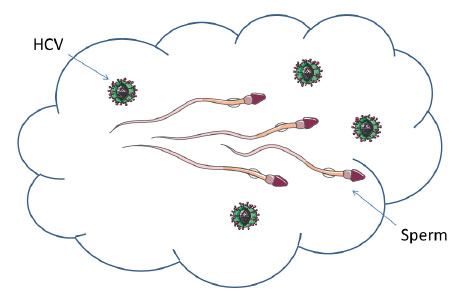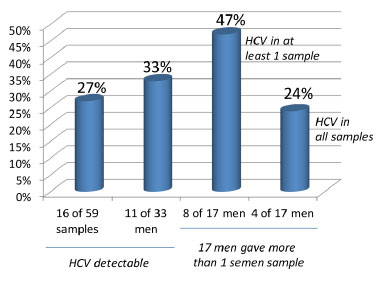September 2016
___________________________________________________________________________________
HCV infection kills more people in the United States than any other infection, including HIV.2 Research over the past several years confirmed an epidemic of sexually transmitted HCV in HIV-positive gay and bisexual men in the United States, Western Europe, and other places.3 HIV and HCV can both pass from one sex partner to another in semen or blood, so people infected with one of these viruses often get infected with the other virus. Research in the United States established that receptive anal sex (being the bottom) without a condom is the main sexual risk factor for HCV infection in gay and bisexual men.4,5 Because the penis rarely bleeds during anal sex, it seems likely that HCV passes to an anal sex partner in semen, not in blood.
Researchers in the United States conducted this new study to see how often they could detect HCV in semen and blood of HIV-positive gay or bisexual men with HCV infection. They also wanted to see if HCV levels measured in semen were high enough to explain sexual transmission of HCV between men during anal sex without a condom.
How the Study Worked
The research team invited HIV-positive gay or bisexual men to enter the study. These men had either recent HCV infection (HCV antibody first detectable in the past year) or chronic HCV infection (HCV antibody first detectable more than 1 year ago). Each man was asked to give semen and blood samples every 2 weeks for 6 weeks. At the end of this period, the researchers hoped to have 3 semen samples and 3 blood samples from each study participant. The research team tested each sample to see if they could detect HCV and to measure levels of detectable HCV.What the Study Found
The study included 33 HIV-positive men, 21 (64%) with recent HCV infection and 12 (36%) with chronic (longer) HCV infection. Four men with recent HCV infection had become infected after anti-HCV drugs cured a previous episode of HCV infection. Median (midpoint) age was 36 in men with recent HCV infection and 52 in men with chronic HCV infection. About 60% of both groups were white, about 25% Hispanic, and the rest black. All but 1 man were taking antiretroviral therapy, but 15 men (45%) had a detectable HIV viral load.All study participants said they had receptive anal sex without a condom. Fourteen men (42%) said they also injected drugs.
The researchers
analyzed 59 semen samples. They detected HCV in 16 semen samples (27% of
59), which came from 11 men (33% of 33) (Figure 1).
Median (midpoint) HCV viral load in semen with detectable HCV was about
30 IU (international units) per milliliter of semen. HCV viral load in
blood samples was significantly higher when HCV could be detected in
semen than when HCV could not be detected in semen. In the whole study
group, HCV load in blood reflected HCV load in semen -- the higher the
blood HCV level, the higher the semen HCV level.
The proportion of semen specimens with detectable HCV did not differ significantly between men with recent HCV infection and men with chronic (longer) HCV infection. In the same way, HCV level did not differ significantly between men with recent HCV infection and men with chronic HCV infection.
Eleven men with recent HCV infection gave more than one semen sample. Four of those 11 men (36%) had HCV detectable in at least one semen sample, and 1 man (9%) had HCV detectable in all semen samples he gave. Six men with chronic HCV infection gave more than one semen sample. Four of those 6 men (67%) had HCV detectable in at least one semen sample, and 3 men (50%) had HCV detectable in all semen samples.
On the basis of HCV levels measured in semen in this study, the researchers calculate that an average load of semen would allow between 50 and 6630 particles of HCV to pass into the rectum of the anal sex partner (Figure 2). Other research shows that as few as 10 to 20 HCV particles carried in blood can cause HCV infection in a person exposed to that blood. So the authors of this study believe 50 or more HCV particles in semen is enough to cause HCV infection in a male partner exposed to that semen during anal sex without a condom. They believe that changes in the rectal wall during anal sex -- even if that sex is not bloody -- may allow uptake of HCV carried in semen.
Some studies link rough, bloody anal sex to HCV transmission between gay men. But other studies do not confirm this link. The researchers who conducted the new study believe HCV carried in semen rather than blood largely accounts for the spread of HCV during sex between men. Just as health experts have long accepted that hepatitis B virus (HBV) carried in semen -- not blood -- explains sexual transmission of HBV, the authors of this study believe HCV also mainly uses semen -- not blood -- to pass from one partner to another during anal sex.
Wearing a condom during sex is the surest way to prevent a partner with a detectable HIV viral load from passing HIV to a sex partner. Condoms can also stop HCV from passing between sex partners. And condoms can block other infection-causing viruses and bacteria from passing between sex partners. Sometimes people with HIV feel safe not wearing a condom during sex if they have an undetectable HIV viral load. But those HIV-positive people can pass HCV and other infection-causing agents to sex partners if they don't wear a condom. And the partner with HIV can pick up other disease-causing viruses and bacteria during sex without a condom. HIV-negative people who use Truvada as PrEP to protect themselves from HIV may feel safe not using a condom during sex. But without a condom they expose themselves to HCV and other causes of infection, because Truvada PrEP protects only from HIV.
Finally, it's important to note that 4 of 21 men (19%) with recent HCV infection in this study had been cured of an earlier HCV infection by anti-HCV drug therapy. One bout of HCV infection does not protect people from getting infected with HCV again. People who continue having sex without condoms or sharing drug-injecting equipment run a risk of another HCV infection regardless of how many times they were infected with HCV in the past.
The proportion of semen specimens with detectable HCV did not differ significantly between men with recent HCV infection and men with chronic (longer) HCV infection. In the same way, HCV level did not differ significantly between men with recent HCV infection and men with chronic HCV infection.
Eleven men with recent HCV infection gave more than one semen sample. Four of those 11 men (36%) had HCV detectable in at least one semen sample, and 1 man (9%) had HCV detectable in all semen samples he gave. Six men with chronic HCV infection gave more than one semen sample. Four of those 6 men (67%) had HCV detectable in at least one semen sample, and 3 men (50%) had HCV detectable in all semen samples.
What the Results Mean for You
One third of the HIV-positive and HCV-positive gay or bisexual men in this U.S. study had HCV detectable in their semen. If these men were not wearing a condom during sex, they could expose anal sex partners to HCV whenever they had HCV in semen and ejaculated inside a partner. These findings help explain why there is an HCV infection epidemic in gay and bisexual men who have sex.3On the basis of HCV levels measured in semen in this study, the researchers calculate that an average load of semen would allow between 50 and 6630 particles of HCV to pass into the rectum of the anal sex partner (Figure 2). Other research shows that as few as 10 to 20 HCV particles carried in blood can cause HCV infection in a person exposed to that blood. So the authors of this study believe 50 or more HCV particles in semen is enough to cause HCV infection in a male partner exposed to that semen during anal sex without a condom. They believe that changes in the rectal wall during anal sex -- even if that sex is not bloody -- may allow uptake of HCV carried in semen.
| High HCV Levels in Semen |
 |
|
Figure 2. Levels of HCV particles in semen of gay or bisexual
men with HIV and HCV infection are probably high enough to let HCV pass
through the wall of the rectum of sex partners if men have anal sex
without a condom. (HCV and sperm illustrations, which are not to scale,
from Servier PowerPoint Image Bank.) |
Some studies link rough, bloody anal sex to HCV transmission between gay men. But other studies do not confirm this link. The researchers who conducted the new study believe HCV carried in semen rather than blood largely accounts for the spread of HCV during sex between men. Just as health experts have long accepted that hepatitis B virus (HBV) carried in semen -- not blood -- explains sexual transmission of HBV, the authors of this study believe HCV also mainly uses semen -- not blood -- to pass from one partner to another during anal sex.
Wearing a condom during sex is the surest way to prevent a partner with a detectable HIV viral load from passing HIV to a sex partner. Condoms can also stop HCV from passing between sex partners. And condoms can block other infection-causing viruses and bacteria from passing between sex partners. Sometimes people with HIV feel safe not wearing a condom during sex if they have an undetectable HIV viral load. But those HIV-positive people can pass HCV and other infection-causing agents to sex partners if they don't wear a condom. And the partner with HIV can pick up other disease-causing viruses and bacteria during sex without a condom. HIV-negative people who use Truvada as PrEP to protect themselves from HIV may feel safe not using a condom during sex. But without a condom they expose themselves to HCV and other causes of infection, because Truvada PrEP protects only from HIV.
Finally, it's important to note that 4 of 21 men (19%) with recent HCV infection in this study had been cured of an earlier HCV infection by anti-HCV drug therapy. One bout of HCV infection does not protect people from getting infected with HCV again. People who continue having sex without condoms or sharing drug-injecting equipment run a risk of another HCV infection regardless of how many times they were infected with HCV in the past.
References
- Turner ST, Gianella S, Yip MJS, et al. Shedding of hepatitis C virus in semen of HIV-infected men. Open Forum Infect Dis. 2016;3(2):ofw057.
- Centers for Disease Control and Prevention. Surveillance for viral hepatitis -- United States, 2014. May 2016.
- Kaplan-Lewis E, Fierer DS. Acute HCV in HIV-infected MSM: modes of acquisition, liver fibrosis, and treatment. Curr HIV/AIDS Rep. 2015;12:317-325.
- Fierer DS, Uriel AJ, Carriero DC, et al. Sexual transmission of hepatitis C virus (HCV) among HIV-infected men who have sex with men (MSM), New York City, 2005-2010. MMWR Morb Mortal Wkly Rep. 2011;60:945-950.
- Witt MD, Seaberg EC, Darilay A, et al. Incident hepatitis C virus infection in men who have sex with men: a prospective cohort analysis, 1984-2011. Clin Infect Dis. 2013;57:77-84.
Related Stories
| One-Third of MSM Group With HIV/HCV Sheds HCV in Semen | |||
| Hepatitis C Drives Non-AIDS Event Rate in 320 HIV Controllers | |||
| Are Hepatitis C RNA Tests Too Variable for Planning 8-Week Treatment Regimens? |
| Read more articles from The Body Pro, here. |


No comments:
Post a Comment
Note: Only a member of this blog may post a comment.